- Visual voicemail offers a free and straightforward method of translating voicemail messages into written documents.
- Basic visual voicemail services are baked into smartphone operating systems while others are available from third-party providers.
- Some visual voicemail apps include additional services, such as out-of-office messages and personalized responses.
- This article is for professionals interested in using visual voicemail to save time and streamline communication.
It’s been nearly two decades since the first visual voicemail services reached the market. The speech-to-text translation space has evolved considerably since then. Today, products offer more accurate transcriptions amid a broader selection of service providers.
We’ll explore how visual voicemail can benefit organizations and busy professionals and share some free visual voicemail apps to consider.
What is visual voicemail?
Visual voicemail services transcribe voicemail messages into text. In the past, if someone left you a voicemail, you would receive a notification that you’d missed a call and that a message was waiting for you. If you received more than one voicemail, you had to listen to them in reverse chronological order.
With visual voicemail, crucial information is provided in text form. You don’t need to dial in to find out who called, how long each message is and what it contains. You can view messages in any order, clicking through to hear the recording at any point.
Visual voicemail platforms typically provide the following essential information:
- The caller’s name and number
- When they called and how long the voicemail message lasted
- The date and time of the call
- What was said in the message
The word “voicemail” was first used in 1980 as a trademarked term by Televoice International. Since then, it has become a generic term for answering machine features in business phone systems, landlines and smartphones.
What are the best visual voicemail solutions?
Here’s a look at seven of the best visual voicemail packages and their platforms. These solutions should work on multiple networks and devices except for the Android, or iOS-specific services, which we’ve noted.
1. iPhone voicemail (iOS only)
One of the original iPhone innovations in 2007 was an app offering speech-to-text voicemail transcription. Today, to access your iPhone’s built-in visual voicemail, open the dialer app and tap the voicemail icon in the bottom right-hand corner. You’ll be prompted to set up your visual voicemail inbox if you haven’t already.
If you’re connected to an audio-only automated voicemail system, your carrier won’t provide visual voicemail. If you want to access visual voicemail, downloading a third-party option is your best bet.
If you’re debating iOS vs. Android for your business, consider how deeply you rely on Apple or Google products, such as iCloud and Google Docs, in your day-to-day operations.
2. Android voicemail (Android only)
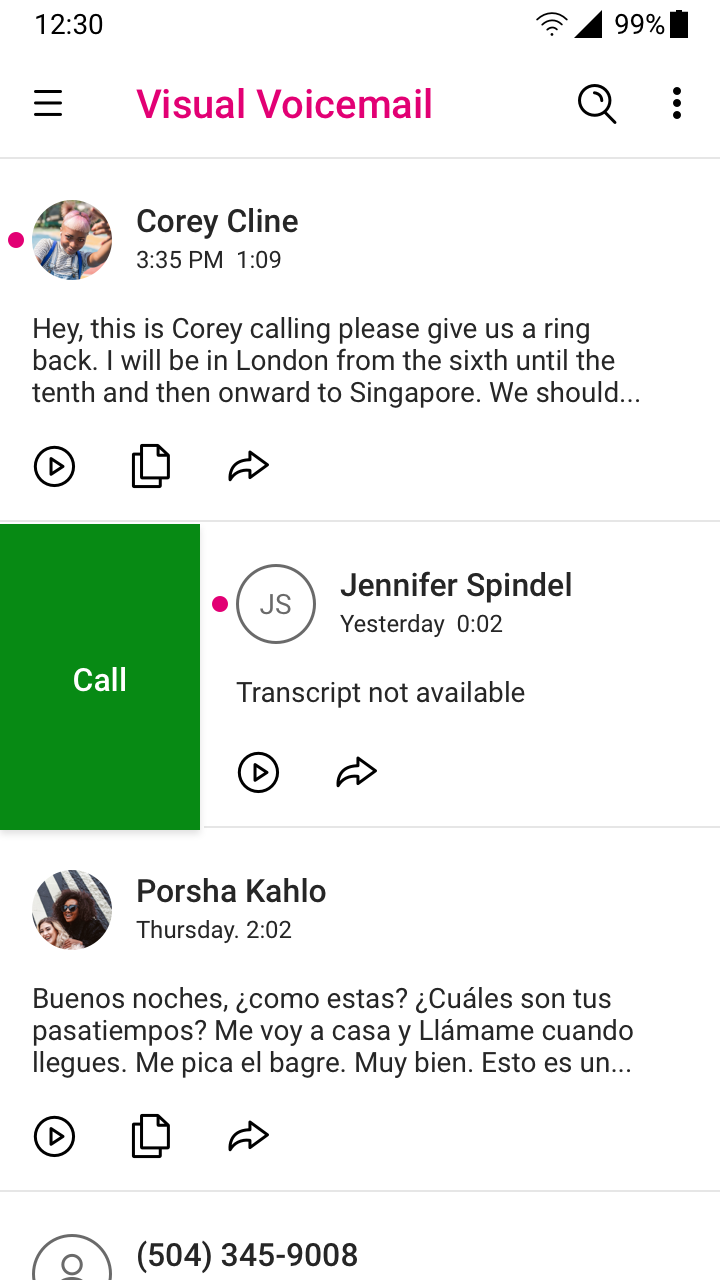
Where Apple leads, Google’s Android operating system tends to follow, although this often happens in reverse as well. Android’s built-in visual voicemail service lets you view voicemail messages in text form.
To view voicemails, go into the dialer and select or swipe over to voicemails. When you open each logged voicemail, you should see a Play button (for listening to the message) and transcribed message text.
If you have an older Android phone or your service provider doesn’t offer visual voicemail, try downloading a third-party app.
The best Android email apps include Outlook for Android, Gmail, Email by Edison and Newton Mail.
3. YouMail
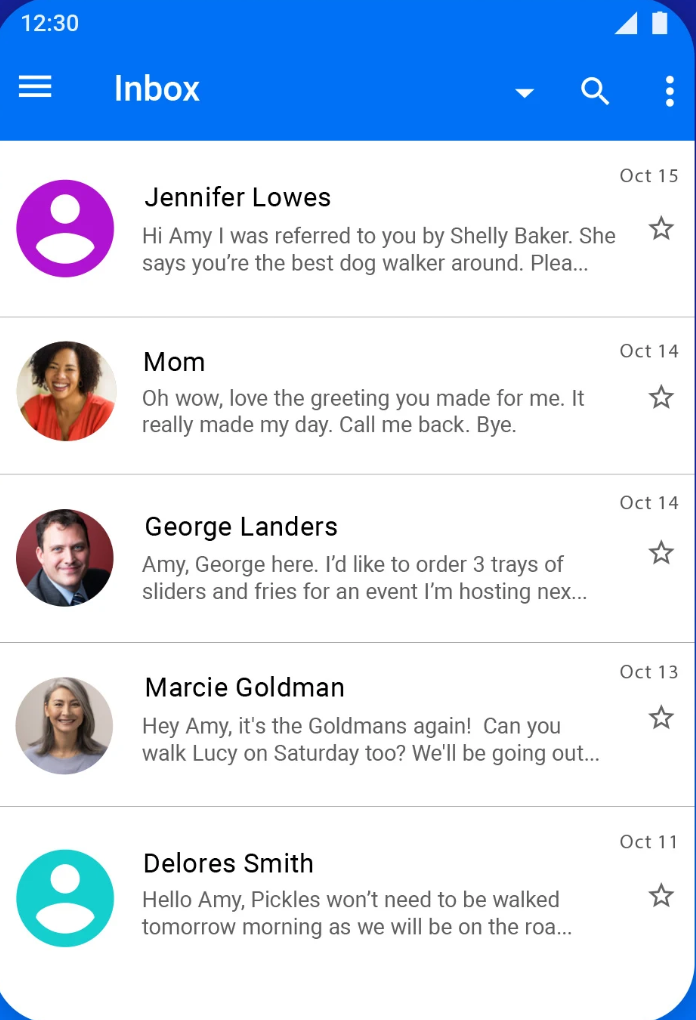
As the original third-party multiplatform visual voicemail service, YouMail claims to stop annoying spam calls and telemarketers with smart caller ID, giving your visual voicemail a junk mail folder.
Other features include the ability to access your voicemail from any device through the cloud and hold conference calls. A Professional account has additional business-centric features, including unified voicemail for multiple phones, auto-reply, call routing and the ability to record greetings.
YouMail’s basic package is free, but its monthly premium services start at $11.99. Subscriptions can include other services such as call blocking, virtual phone numbers and even virtual receptionists.
Download the YouMail app for iOS or get the Android YouMail version.
4. Google Voice
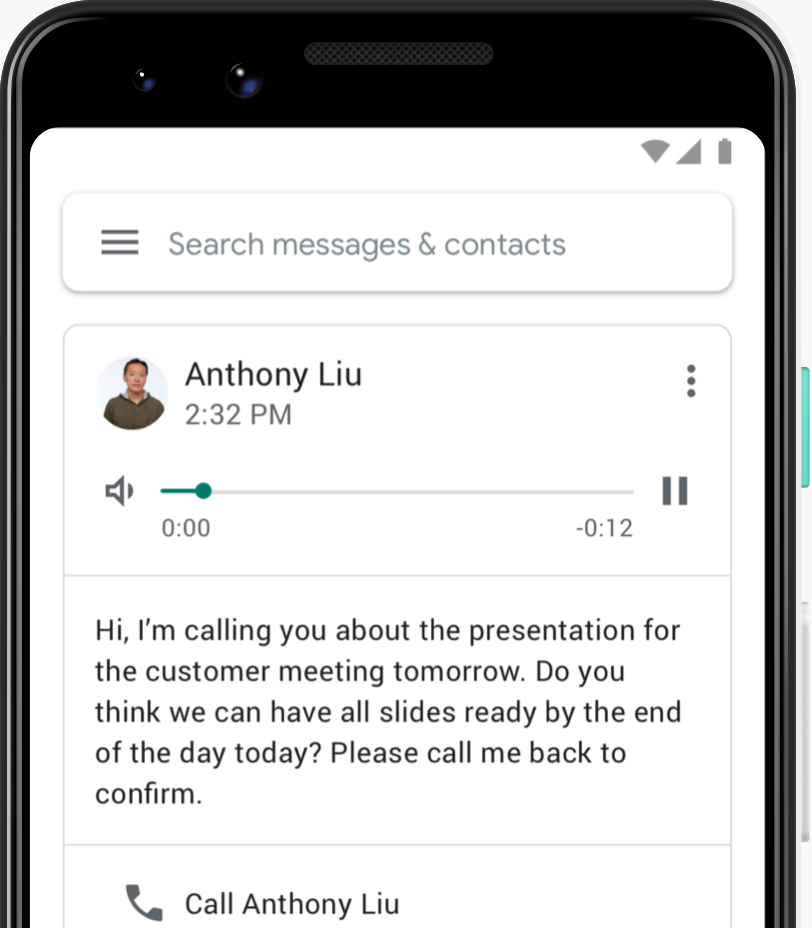
The Google Voice service gives you a phone number for calls, texts and voicemails. This phone number can serve as your business phone number. To sign up for Google Voice, you need a Google account and a United States landline or mobile phone number. Text messaging isn’t supported in all geographical locations.
A key aspect of the Google Voice system is that it transcribes reasonably well. You can even have transcriptions emailed to you via Gmail. Google Voice is particularly useful for people who make many international calls or for anyone already embedded in Google’s ecosystem, such as Chromebook users.
Download the Google Voice app from the Google Play Store or get the iPhone Google Voice version.
If your business’ communication needs are more extensive, consider employing one of the best call center and answering services to ensure your critical calls are answered and handled professionally.
5. InstaVoice
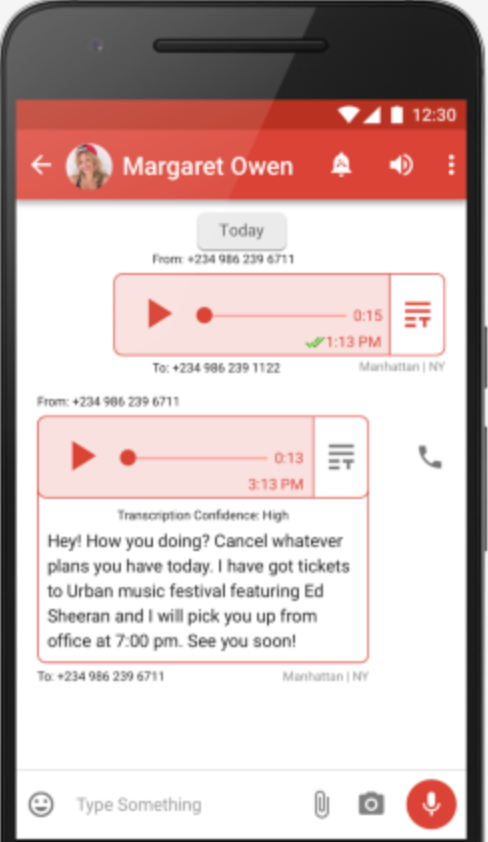
While rival platforms have introduced minimum charges, InstaVoice continues to offer free and unlimited visual voicemail alongside missed-call alerts and voice short message service (SMS).
The InstaVoice voicemail management system allows you to organize, view and reply to messages in various ways. The chat interface organizes your most important conversations, allowing you to review missed calls, text messages and visual voicemail transcriptions.
You can use the app to send voice messages to your recipient through SMS. Your account can store unlimited messages and you can access your voicemail through any device or via your email.
Premium features, including transcription and voice messages, cost credits, with the app charging 99 cents for 100 credits and $4.99 for 500 credits.
Download InstaVoice for iOS or get InstaVoice for Android.
6. Voxist
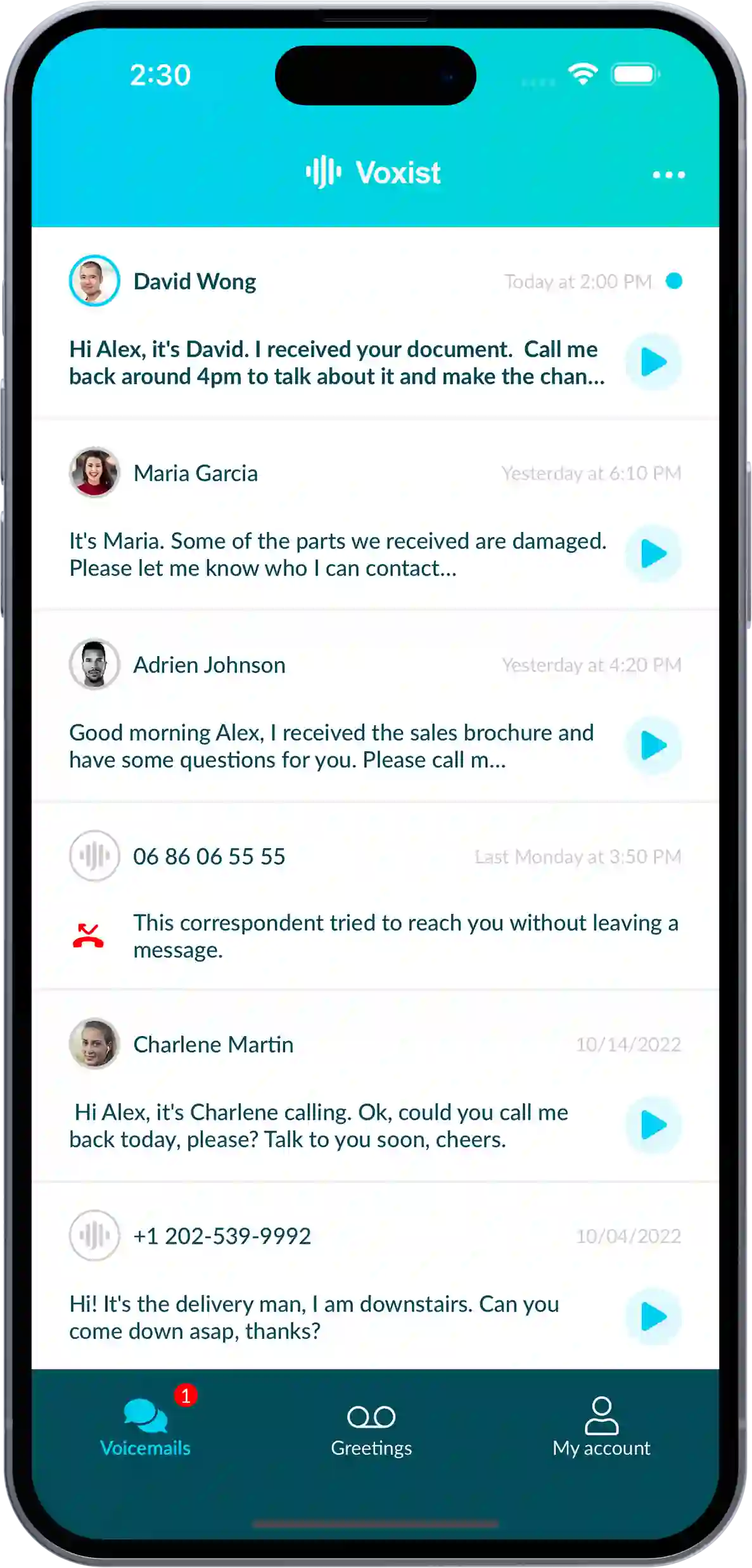
Although it’s not available in all territories, Voxist is a free visual voicemail service that allows 10 monthly transcriptions for one number. Transcripts and audio recordings are also available via email.
With the premium service ($4.99 per month), you get 30 monthly transcriptions and even bilingual transcriptions, which is ideal if you regularly field calls from people who speak other languages.
Download Voxist for iOS or get Voxist for Android.
7. Hi Voicemail (iOS only)
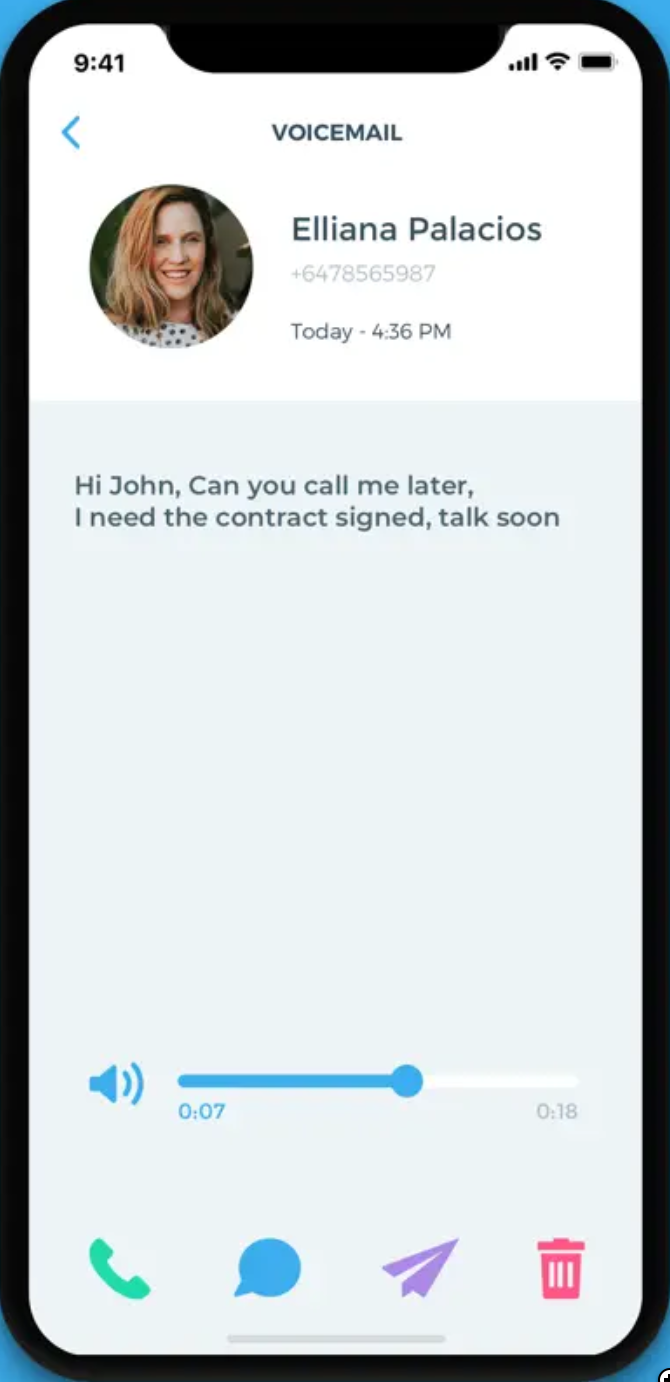
Offering unlimited free visual voicemails, Hi Voicemail is an iOS-only service with free voicemail personalization, preset greetings, cloud storage and spam protection.
Customers willing to upgrade to the PRO version ($5.99 per month) receive an ad-free interface with multiple greetings (including location-specific ones) and the ability to automatically forward voicemails to email.
Download Hi Voicemail for iOS from the App Store.
The best iPhone business contact management apps have artificial intelligence functionality to gather contact information from social media accounts, contact managers and the cloud.
What are the benefits of visual voicemail?
Visual voicemail has various benefits for businesses, including the following.
- Study messages at a glance with visual voicemail: If you’re standing in an airport arrivals lounge with eight voicemails and a suitcase to track down, glancing at who called and what they said helps prioritize responses and maximize productivity. As a bonus, you don’t have to listen to lengthy pocket-dialed messages from people who didn’t know they called you.
- Access messages no matter your signal strength with visual voicemail: With visual voicemail, you don’t need a strong phone signal to hear the message without distortion or momentary dropouts. Voicemails often arrive while you’re in areas of low or no signal, preventing you from dialing in to retrieve the message. If you’re in a noisy environment, you don’t have to struggle to hear what’s being said.
- Share information easily with visual voicemail: Once voicemails are transcribed, you can share information easily with colleagues and clients by copying and pasting parts of the transcription into an email. Some services are even preprogrammed to let you forward voicemail transcriptions to an email account. A written record of a message is often invaluable later.
- Enjoy more discretion, privacy and calm with visual voicemail: Reading a written message can be easier and less stressful than listening to an audio recording in many circumstances. Hearing an angry voice can be disconcerting and stressful while reading their comments can help you feel more composed and detached.
- Gain additional services with visual voicemail: Visual voicemail apps often come with additional services, including the ability to record individual greetings for specific contacts, broadcast an out-of-office message or prevent unwanted callers from leaving a message.
The ability to broadcast an out-of-office message is helpful when setting up summer hours for your business, when working hours are often modified.
What are some mobile carrier offerings?
Several mobile networks, such as AT&T and T-Mobile, offer proprietary visual voicemail apps. These apps allow you to play voicemails in a specific order, organize messages and read voicemail transcripts. Essentially, mobile carrier visual voicemail apps set up voicemails as though they’re in an email inbox, letting users sort through them and play whichever ones are relevant. You can also make callbacks using the apps from the voicemail screen.
Many mobile carriers also offer enhanced caller options through their visual voicemail apps. For example, verified business calls will display the company name, logo, contact image and reason for the call, so you aren’t guessing who’s calling and why. Some of these apps also enable voicemail-to-text for convenience.
These apps might be of interest to loyal customers. However, bear in mind that embedding yourself further in a specific network’s infrastructure makes it harder to switch providers at a later date.
Is visual voicemail right for me?
Professionals can use visual voicemail to save time and streamline communication. Many voicemail apps are either free or part of a mobile carrier’s plan and offer an array of benefits to professionals, including convenience and enhanced organization. Using visual voicemail apps, you can read through voicemail transcripts to understand which calls are most important and require immediate or quick replies and share the information with relevant parties.
For more extensive features, you can also purchase premium plans at a monthly cost.
Sammi Caramela contributed to this article.
Read the full article here










